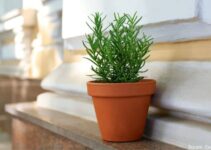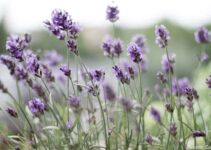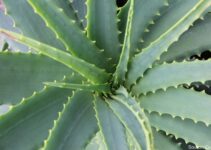Adding color and visual interest to your garden can also mean adding delicious fruit. Whether the tree keeps red leaves all year or simply turns its green leaves to a showy crimson blaze as the seasons change, these 13 fruit trees with red leaves will help inspire your next landscape addition.
13 Fruit Trees With Red Leaves
1. American Cranberrybush
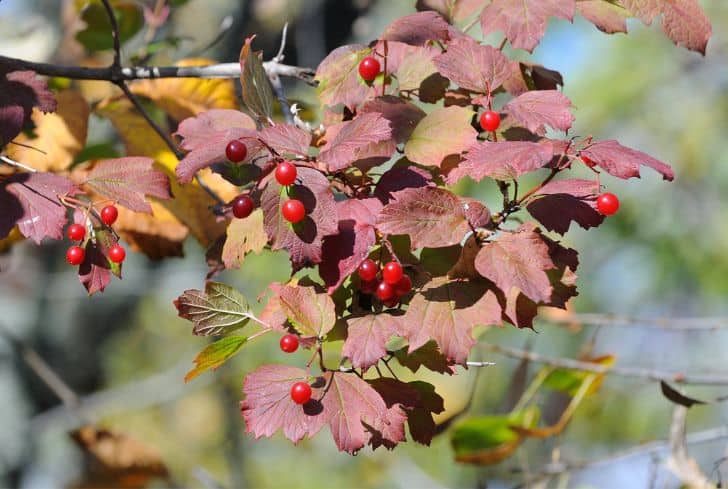
While the American Cranberrybush doesn’t present with red-colored foliage all year long, its green leaves do turn a stunning vibrant red hue in the Autumn months. The cranberry fruit is another reason that so many gardeners and landscapers turn to the American Cranberrybush. The fruit is delicious when preserved into jams and jellies and often served with different types of cheeses.
American Cranberrybush trees reach a maximum height of 8-10 feet, making it the perfect small to medium sized tree for your garden or outdoor space. The tree can be grown in USDA zones 2 to 7 and prefers to be planted in full sun or slight shade.
2. Weeping Crabapple
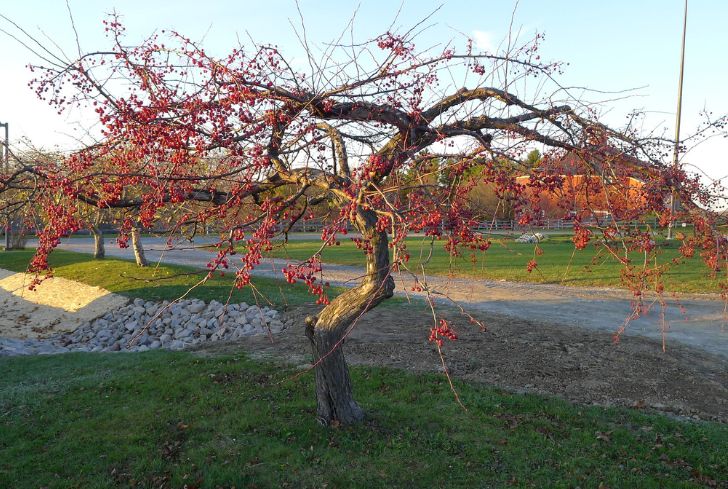
Grown in USDA zones 4-7, Weeping Crabapple trees provide the visual interest you are hoping for in your garden. The trees only reach a maximum height of 8-10 feet high and 12-15 feet wide. Weeping Crabapple trees have long willowy branches that reach toward the ground with deep green to red foliage.
The trees also produce stunning white and pink flowers in springtime bringing bees, butterflies, birds, and other pollinators to your garden space. After the flowers have been pollinated and faded, small red berries form. Crabapples are edible for humans but tend to be enjoyed by wildlife and birds more. Crabapples are often cooked into jams and jellies.
3. Bailtiger (Rhus Typhina)
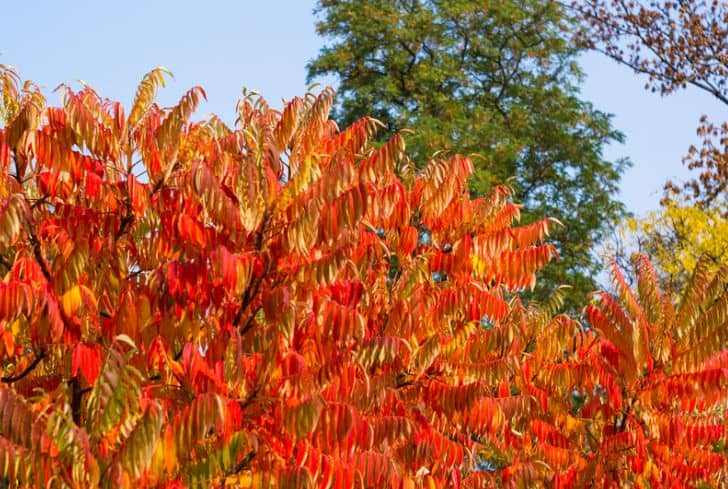
Grown in USDA zones 5-8, the Bailtiger is a Sumac tree that presents with vibrant scarlet leaves, maroon berries, and purplish stems. The shrub is non-aggressive and has a tolerance for seasons of drought, making it a favorite for gardeners and homeowners alike.
The Bailtiger grows to a mature height of 3-6 feet and has a matching spread. Many who plant the shrub like to use it in live hedges or edging their property. The shrub loves full sun but will tolerate part shade, especially in the southern part of its grow zones where the summer sun may be too hot during the peak afternoon hours.
4. Crabapple
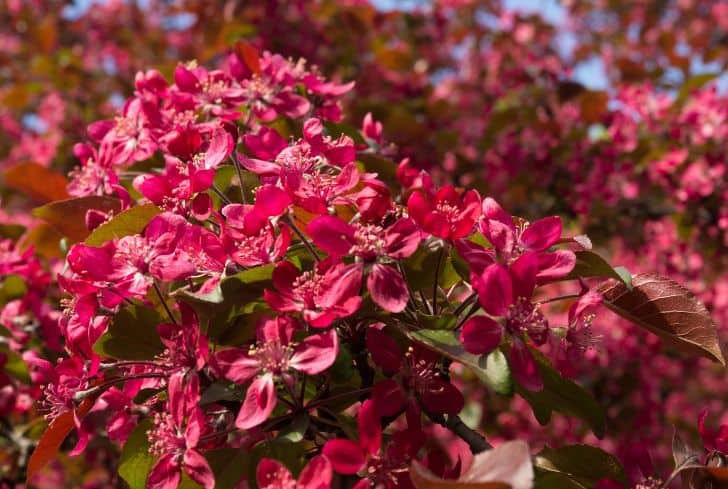
Crabapple trees are often chosen for their unique foliage and stunning flowers. The leaves of the tree are purplish in color, making a stunning contrast between the white or red blossoms that the tree blooms in spring. After the flowers have been pollinated, Crabapple trees produce crabapple fruit which can be made into jams and jellies.
A slightly larger tree for garden spaces, crabapple trees grow to be 12-15 feet high and wide at maturity. They also require full sun to create enough energy to produce bountiful blooms each spring. Gardeners and homeowners in the USDA zones 5-8 can choose from a variety of crabapple tree types, some of which have red, purple, or green foliage.
5. Red Chokeberry
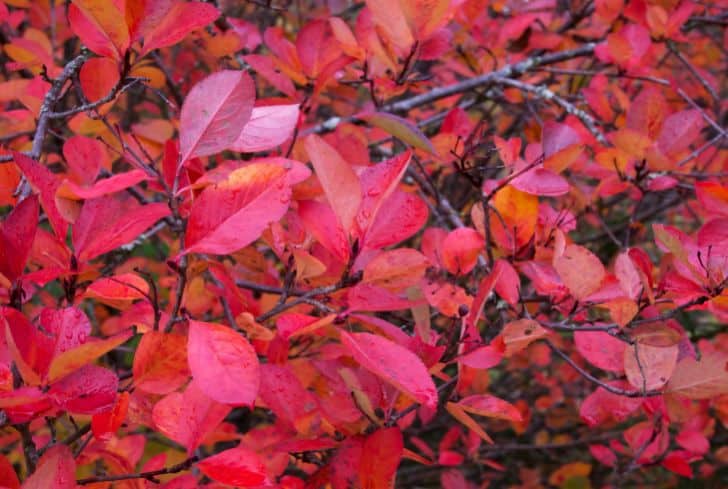
The Red Chokeberry is a stunning tall shrub that boasts bountiful white flowers in the spring before they turn to clusters of glossy red berries. The shrub grows 6-10 feet in height and 3-5 feet wide on multiple stems, making it great for homeowners looking to create a living fence or hedge.
Red Chokeberries are edible but are extremely tart. When preparing the chokeberries for human consumption, many people prefer them in jams or jellies. Others grow the tree for its stunning floral display of tiny white flowers in the early to mid springtime.
The Red Chokeberry should be planted in full sun but it will tolerate part shade in USDA zones 4-9. The shrub has green foliage during the spring and summer but turns to a showy and exciting shade of red in the autumn.
6. Japanese Barberry
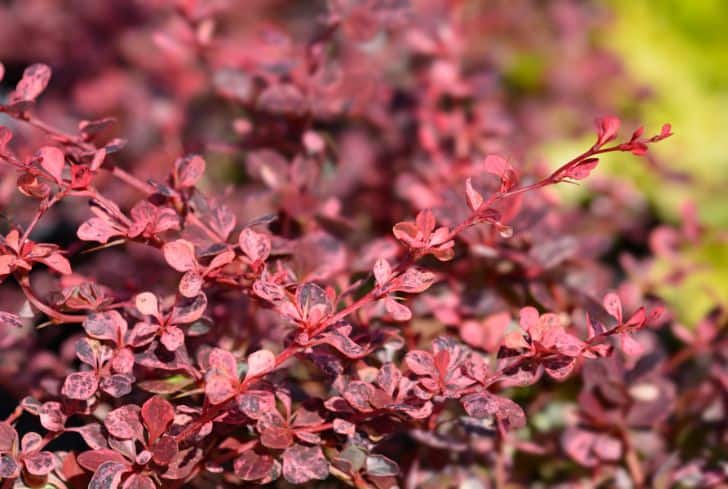
Bursting of tiny, red oblong leaves, vibrant yellow flowers, and tiny berries, the Japanese Barberry may be the perfect addition to your garden or outdoor space. Only growing to a maximum height of 2 feet tall and 3 feet wide, this tiny and unique tree is eye-catching and conversation inducing.
The Japanese Barberry tree will bloom with yellow flowers in the spring and summer months before bearing berries in the fall. Grown in USDA zones 4-8, this tree may be grown both in the ground as well as in pots, making it easy to decorate your patio or deck with this red-leaved beauty.
7. Red Balloon Viburnum
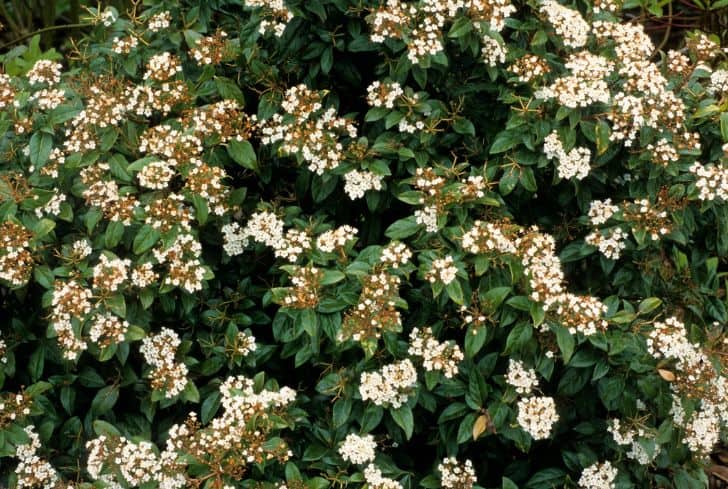
The Red Balloon shrub is an excellent addition to almost any garden or landscape in the USDA zones 4-8. These trees grow to be 6-8 feet tall and wide and are resistant to deer and rabbits. It is also heat tolerant and attracts many bees, butterflies, and birds. The plant blooms clusters of tiny white flowers that turn to tiny berries after pollination. The berries aren’t edible for humans, but wildlife enjoy them.
The leaves of the Red Balloon are green during the spring and summer months. However, they turn to a vibrant red as autumn arrives before dropping their leaves in the winter months.
8. Lovi-lovi
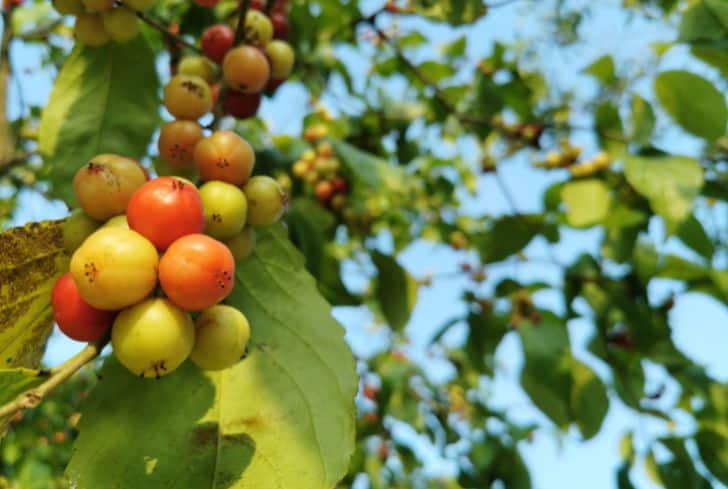
Also called the Batoko plum, the Lovi-lovi tree is autotrophic. Being autotrophic means that the tree can produce its own food from carbon dioxide. The tree is relatively slow growing and will take many years before reaching its mature height and spread of 50 feet.
Lovi-lovi doesn’t have showy red leaves its entire life, but does present with orangish red leaves when the tree is young. The tree also produces fruit clusters year round. Lovi-lovi is a tropical evergreen tree that grows in USDA zone 10 in full sun.
9. Great Wall Persimmon
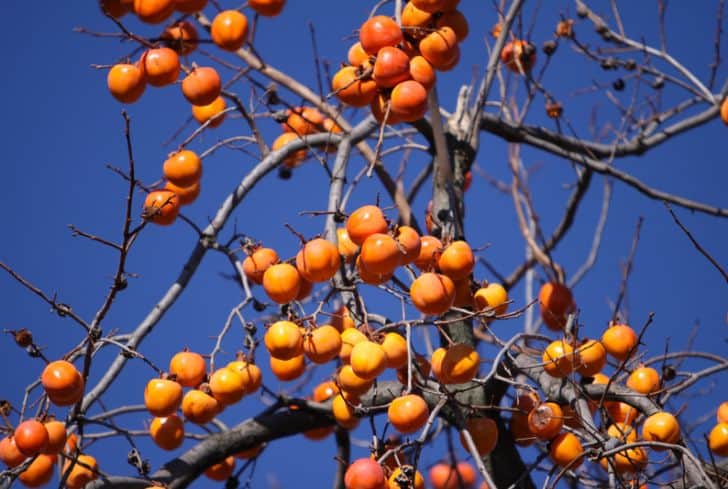
Originated from China, the Great Wall Persimmon has green foliage during the summer months but turns to a vibrant red as autumn appears. Persimmons are delicious fruits that are common throughout Asia and popular in the United States as well. This variety of persimmon is an astringent variety that needs to be eaten when soft.
The Great Wall Persimmon is cold hardy and can be grown in USDA zones 6 to 9. They will grow to be 15 – 20 feet tall and wide. You will need to plant the tree in full sun to ensure it receives enough energy to produce fruit.
10. Bonfire Peach
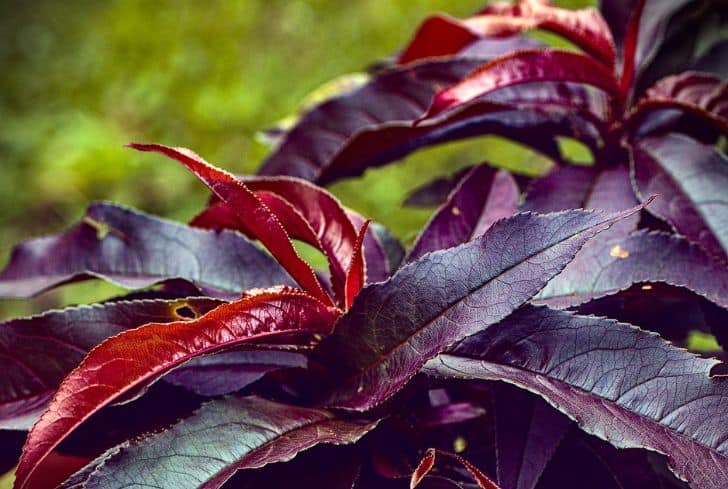
If you are looking for a unique fruit tree with colored leaves, the Bonfire Peach may be perfect for you. Whether you grow the 4-6 foot tree in a pot on your patio space or planted in your yard or garden, the purple leaves and pink flowers are sure to draw attention.
Bonfire Peach grows best in USDA zones 5-9 and can commonly be found in Alabama, Connecticut, and Delaware. The tree blooms soft pink flowers every spring that will attract butterflies, birds, bees, and other pollinators to your space.
While the tree is stunning, pruning and caring for the tree requires more work than other red-leaved fruit trees. Plant the Bonfire Peach about 10 feet apart if growing more than one to allow enough space for the mature plant to grow.
11. Thundercloud Cherry
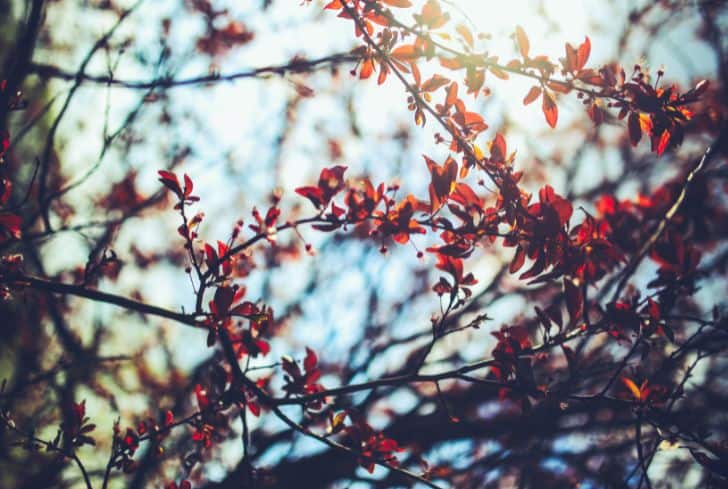
Perhaps one of the most beautiful trees on this list is the Thundercloud Cherry. This tree towers over many of the others with a height of 15-20 feet at maturity. Thundercloud Cherry also boasts stunning pinkish white flowers that bloom in early spring and create a brilliant contrast between the tree’s deep red leaves.
Thundercloud Cherry grows best in full sun but will tolerate part shade in USDA zones 5-8. Unfortunately, the tree is prone to pests and diseases and will require more work and maintenance than other red leaved trees.
12. Winterberry Holly
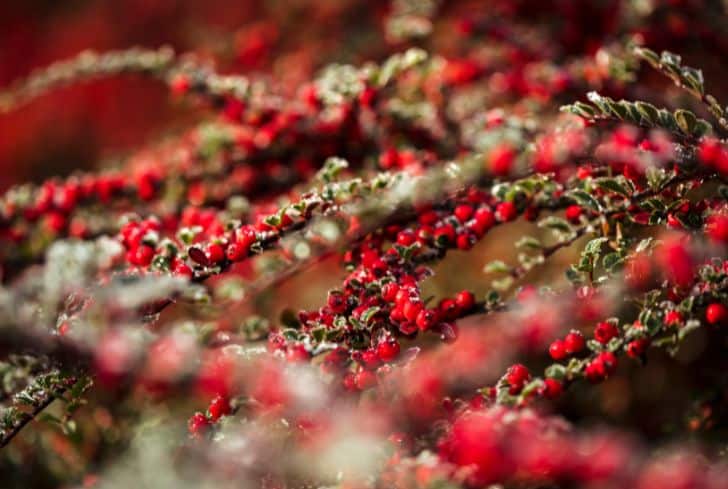
While the tree itself has green leaves during the spring and summer, the Winterberry Holly will drop its leaves once winter comes, leaving behind its stunning clusters of red glossy berries.
Winterberry Holly produces white flowers in the springtime. Be sure to plant both male and female holly plants to ensure crops. However, while the berries are beautiful especially when their bold red is backdropped by white snow, the berries are toxic to both humans and pets. Birds do enjoy the berries as a snack, though.
Nevertheless, the Winterberry Holly may not have red leaves, but the shrub does offer pops of red in the winter season when many other plants have lost their leaves. You can grow this holly in USDA zones 3-9 and will thrive in both part shade and full sun.
13. Purple Leaf Plum
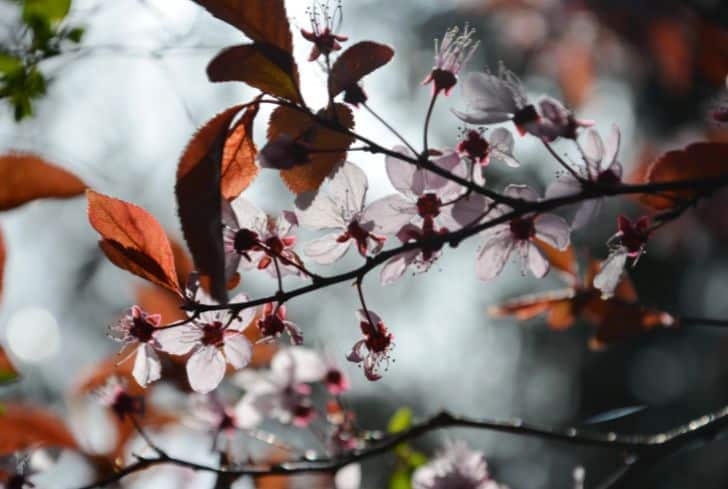
A larger tree on the list reaching a height and width of 25-30 feet at maturity, the Purple Leaf Plum can add some bold color to your garden or landscape. The tree has showy deep purple to reddish colored leaves that make it stand out amongst green-leaved trees and plants.
During the springtime, Purple Leaf Plum trees produce an abundance of white to pink flowers that will pop against the dark colored foliage. While the tree does produce plums, they are very tart and tend to do better in jams or jellies than eaten raw.
Best grown in USDA zones 4-9, the Purple Leaf Plum tree is prone to many types of pests and disease, making it more high maintenance than other red-leaved trees.
